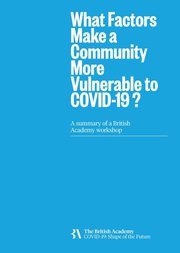What factors make a community more vulnerable to COVID-19?
by Dominic Abrams, David J Hand, Anthony Heath, James Nazroo, Lindsay Richards, Saffron Karlsen, Melinda Mills, Charlotte Roberts and Centre for Homelessness Impact

- Year
- 2020
- Publisher
- The British Academy
- Number of pages
- 46
Summary
In July 2020, the British Academy convened a workshop, chaired by Professor Sir Ian Diamond FBA, on what we know and need to know about the factors affecting the prevalence of COVID-19 in different communities. A holistic, multidisciplinary approach is needed to understand the causes of vulnerability and the workshop brought together distinguished researchers across a range of disciplines with insights into the available evidence.
The discussion considered the broad impact of the virus on vulnerable communities, including those who do not have access to different services (health, transport, employment, education) or those who are marginalised in society (social inequalities including those associated with faith, sex, race, age). Two central questions were considered:
a) what do we know and where are the gaps in what we know; and
b) how do we prepare for a potential second surge in the disease.
The most significant theme to emerge from the discussion was the importance of the local: this requires data, knowledge and communication in the context of the local level, and implies building analytical capability as well as links to leaders and civil society at a local level. Supporting this theme are six messages:
- Existing structural and health inequalities must be recognised to address their role as underlying causes of vulnerability.
- There will be longer term societal impacts of the pandemic. In managing these we must prepare for them with equal urgency as we did with the short-term strategies implemented to manage the disease. We need to use multiple types of evidence to foster community resilience to multiple stressors in the context of changing employment structures and opportunities.
- We need to connect a sufficiently improved local track and trace system to knowledge and experience at local levels.
- We need to better understand the social dynamics linking medical, social, and economic factors and social resilience in communities, taking a longer view. Dialogue and policy responses need to focus more on behaviour and context, not groups and categories.
- We need to learn better and quicker from existing knowledge and experience at local levels. Localisation of evidence and analytical capacity will be critical.
- Communication will need to be coordinated and targeted more sensitively, making better use of trusted and more local leadership.
There were also two cross-cutting methodological themes. Methodological innovation and greater capacity are required to capture the social dynamics, connections, structures and relationships involved in community vulnerability. Effectiveness of policies and interventions will be improved if supported by additional social science input to provide:
a) greater local specificity and contextualisation of evidence (adequacy and extent of measurement and monitoring of both COVID-related and other behaviours and attitudes relevant to the above) and
b) strengthened local capacity to collect, analyse and interpret that evidence (local authority research and analysis function, staffing, training etc).
This summary elaborates these main points and highlights the common themes around how to identify and support vulnerable communities, exploring ways to reduce the impact of the virus itself and prevent COVID-19 from exacerbating inequalities. The points synthesise those raised that received general assent during the workshop rather than being attributed to specific individuals.